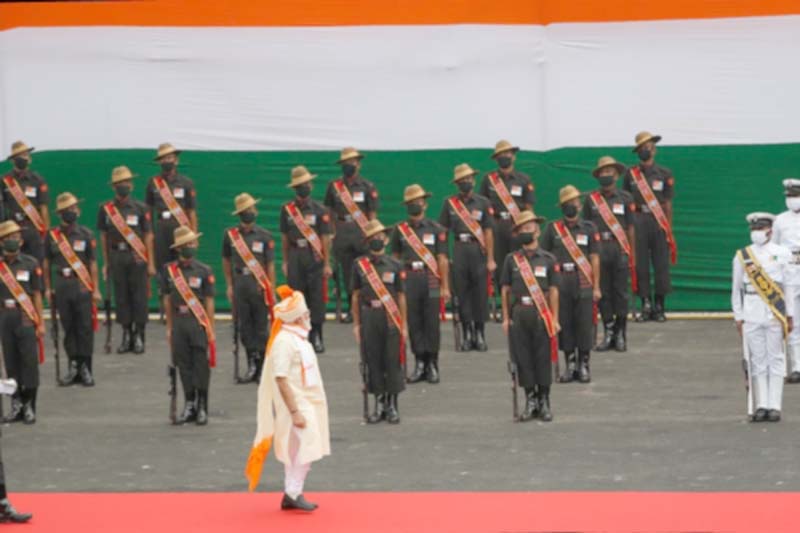Narendra Modi’s scheme of short-term contractual soldiers is motivated by financial constraints but will have a direct bearing on Indian society
By Sushant Singh
“It’s the economy, stupid.” The iconic phrase that guided Bill Clinton’s victory over George H W Bush in the 1992 presidential election in the United States has unleashed itself on the Indian military three decades later. More than half of the Indian government’s defence expenditure of $70.6bn the third highest in the world after the US and China goes towards pensions and salaries for Indian military personnel.
It was shooting upwards by the year and Prime Minister Narendra Modi’s Hindu nationalist government was unable to initiate a substantive reform within the existing structure. So the Indian government on Tuesday decided to demolish the structure itself. Instead of recruiting professional soldiers to serve for a full career of pensionable service, the Indian military, under a new policy called “Agnipath” (path of fire in Hindi), will now recruit them on a short-term contract basis as “agniveer” (fire-brave in Hindi), a new military rank.
They will be contracted for four years, including the training period and exit without any pension, health or education benefits. Up to a quarter of them may be taken back as regular soldiers afterwards, creating unhealthy competition for retention within the ranks in the bargain. It will fundamentally interfere with how India’s armed forces are organised, with potentially devastating consequences if not handled correctly.
Financial reasons
Even though defence minister Rajnath Singh was quick to resort to the rhetoric of “the military should not be looked through the prism of savings,” there has been a persistent shortfall in allocations for the ministry in the past eight years under Modi. Nearly one-fifth to one-quarter of the demands of the defence services have been unmet by the government, with about 53 percent of the total shortfall in the last budget falling under capital expenditure.
This funds the key modernisation projects of the defence forces that are supposed to keep them technologically abreast to fight a modern war against adversaries like China and Pakistan. The logic is simple: the money saved in salaries and pensions can go towards modernisation. And the government is scrounging for money for the military. Modi has always been full of profuse praise for the Indian military.
He has routinely evoked the courage and sacrifices of the soldiers for political gains in various elections, even dressing up in military uniform on numerous occasions while he holds no formal military rank or position under India’s constitution. The reasons for the decision have thus been conjured up ex post facto, and none of them hold up to serious scrutiny. If these reasons had indeed existed, the government would have at some point in the last eight years conveyed that something was broken with the nearly 1.4 million-strong military that needed to be fixed.
In fact, so copious has been Modi’s praise and the acclaim of the military from his supporters that political opponents, journalists and critics have been lampooned for being inferior to the soldiers. As with other nationalist authoritarians, Modi and his fellow travellers held the military as a near-perfect institution, the epitome of the highest virtue in the land.
‘Demographic disaster’
That is politics, but it has now been trumped by the reality of economics. The Indian economy never recovered after the sudden midnight ban on currency notes announced by Modi in 2016. Wholesale inflation is now at a three-decade high, the Indian rupee is at an all-time low against the US dollar, private investment is in decline, and foreign institutional investors have withdrawn billions from the share market in the last few months.
India’s unemployment rate reached an all-time high in double digits and has only recently recovered, disguised as underemployment as urban residents moved back to villages and were shown to be working in agriculture or as self-employed. The employment situation is so bad that more than half of the 900 million Indians of legal working age roughly the population of the US and Russia combined have even stopped looking for jobs altogether.
With a massive youth bulge, India had boasted of a demographic dividend as other developed economies faced problems of an ageing population. But economic decline, along with poor education and public health levels which have further plunged under Modi, has now raised the spectre of a demographic disaster.
Modi first came to power in 2014. Among his many promises was to create 20 million new jobs every year. However, according to a 2020 report by the McKinsey Global Institute, India needs to create at least 90 million new non-farm jobs by 2030. It is a crisis now staring Modi in the face as he seeks re-election in 2024. Earlier this week, Modi said the government will undertake a special drive to fill vacancies in its offices and offer one million jobs in the next 18 months.
The plan to have short-term contractual soldiers forms part of the same announcement. Having stopped recruitment in the armed forces for the past two years under the guise of the coronavirus pandemic, even as political rallies and big religious events continued unchecked, this will mean more than 100,000 jobs in the military in the next two years. If shortfalls of the last two years have to be made up, these numbers will only rise further. And a faster turnover of these contracted young men would result in the release of more vacancies every year.
No parliamentary discussion
The “agniveer” plan is a job-generation scheme to satisfy a vast number of unemployed Indians, but it comes at a great cost. Most military veterans are worried about the professional capacities of a short-term contracted soldier who has only been trained for six months. The breaking-in of a soldier and his growth in an army unit takes a certain amount of time, they say, and four years may be too short a period in the Indian milieu to gain that experience.
When it comes to the navy and the air force, their manpower needs are far more technical, with officers specialised in their roles and in need of extensive training. These services will find it hard to employ the short-term contractual soldier fruitfully, putting additional pressure on the permanent ones, and resulting in lower operational serviceability of modern weapons and platforms.
A lot of challenges can be seen but there are other unintended outcomes of a sudden and massive change that are a bigger cause for concern. There have been no major studies of the government’s proposal within or outside the Indian defence services, no white paper has been produced by the government, the matter was never debated in parliament or in the parliamentary standing committee on defence and the public was never informed before the announcement was made.
Defence services had reportedly proposed a pilot project of inducting only 5,000 soldiers under this scheme for five years to study the effect before implementation, but that proposal was rejected by the government. A country that faces huge threats on its borders from nuclear-armed China and Pakistan, and is using the army in Indian-administered Kashmir and some areas of the northeast, cannot afford to tinker with its national security structures without adequate planning.
‘Devastating consequences’
The effect of India’s “agniveer” proposal will not solely be on its military or the economy. It will also have a direct bearing on Indian society, which will see an influx of thousands of young men, trained in inflicting violence in an organised manner, every year. A weak economy, where young men have lost hope and stopped looking for jobs, is incapable of absorbing them in a smooth and peaceful manner.
The country has also been in the grip of majoritarian violence in recent months, with Muslims being the prime targets. With institutions of the state largely failing to perform their constitutional roles, the state has ceded its monopoly over violence to Hindutva groups. The demobilised short-term contractual soldiers could provide a major recruiting pool for such groups who wish to use violent means to pursue their ideological goals. The consequences of such an eventuality will be catastrophic.
There is a precedent for it as well. During India’s partition in 1947, districts with larger concentrations of combat veterans from the second world war saw them heavily involved in campaigns to persuade members of other religious communities to leave, in organising mass flights of their own community in areas where they were outnumbered, and in encouraging co-religionists to move into a district where their dominant position seemed tenuous.
Research shows that the most violent ethnic cleansing occurred when members of the majority community gained combat experience as soldiers while the minority community was unorganised. An additional month of combat experience was associated with a 1.1 percent greater reduction in a minority population due to killing, conversion or migration equivalent to 17,000 people per district.
Even ethnic cleansing in places such as former Yugoslavia and Rwanda depended on the availability and skills of the specialists in violence, particularly in environments where the state’s coercive power had been weakened. How different could it be in India’s case? In the communal cauldron that India is today, with its weak state capacity, some of the more ominous warnings about the safety of the country’s religious minorities could eventuate.
Upending the existing military structure through a poorly thought short-term contractual recruitment of soldiers may save a few million for Modi and his government, but the cost of its damaging consequences on the Indian military and more worryingly, Indian society will have to be borne by India. It is something the rest of the world cannot afford to ignore.
Sushant Singh is Senior Fellow at the Centre for Policy Research in New Delhi, India. He has taught at Yale University and was the deputy editor of The Indian Express.







